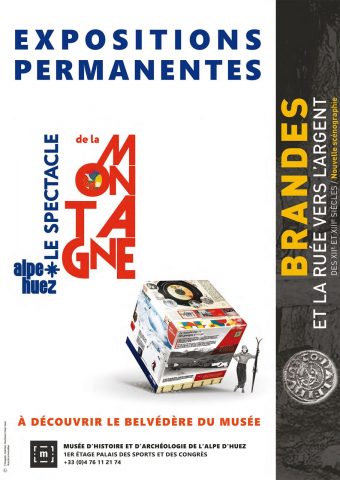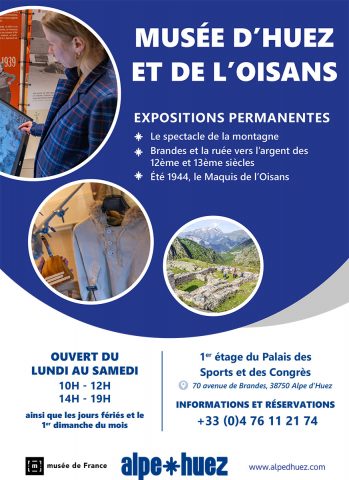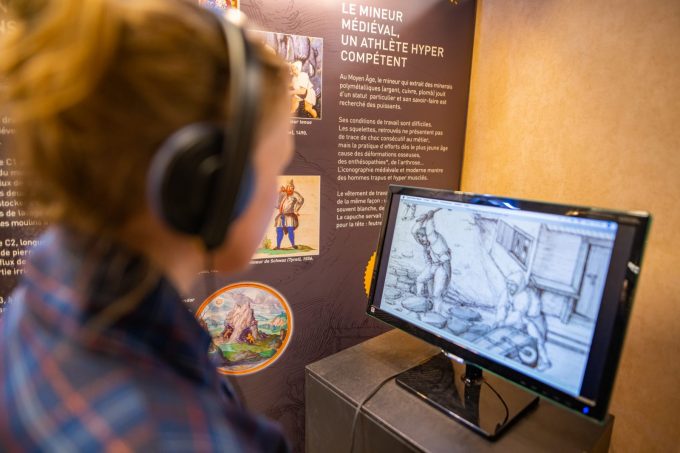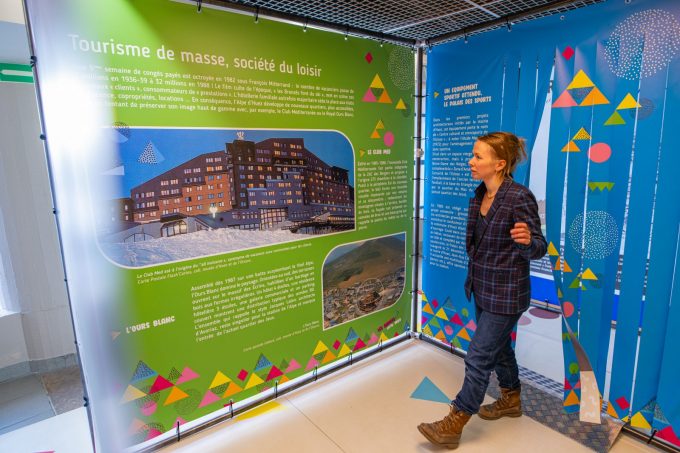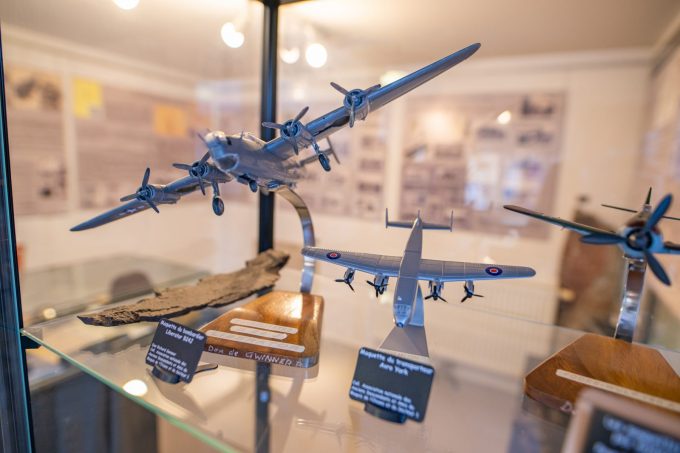The Alpe d'Huez Museum of History and Archaeology is the only structure in a high-altitude resort to have been awarded the "Musée de France" label. It traces the long history of the village of Huez and its alpine pastures, from the Middle Ages to the present day.
About : Alpe d’Huez Museum of History and Archaeology
The museum presents visitors with two new scenographies through the permanent exhibitions "Le spectacle de la montagne" and "Brandes et la ruée vers l'argent des XIIe et XIIIe siècles". There's also a space dedicated to the Second World War, with the exhibition "Eté 1944. Le Maquis de l'Oisans".
3 EXHIBITIONS: "LE SPECTACLE DE LA MONTAGNE", "BRANDES ET LA RUEE VERS L'ARGENT DES XIIE ET XIIIE SIECLES", "ETE 1944. LE MAQUIS DE L'OISANS".
These exhibitions punctuate the visit to the Musée de l'Alpe d'Huez:
"The Mountain Show
Presented from December 2022, this permanent exhibition tells the story of the transformation of the "Vieil Alpe" mountain chalets into hotels, forming an internationally-renowned high-altitude tourist resort from the 1980s-90s onwards. Featuring 4 "historical kiosks" and richly illustrated with photographs retracing the periods 1923-1939, 1945-1973, 1974-1989, 1990-2022, this exhibition with its immersive, explanatory cubes reveals to the curious this rich history, with the role of ski pioneers (Moulin, Chaix, Chalvin, Rajon, Pomagalski etc.), the heyday of the traditional, family-run hotel industry from the 1930s to the 60s, sporting events such as the Tour de France, new snow-related activities such as snowboarding in the 1980s, summer skiing and ever-increasing events such as Tomorrowland Winter. In addition, the architectural and urban development of the resort is highlighted in the exhibition by a touch table (historical and 3D models of the resort's districts) and an interactive terminal featuring several witnesses to this urban development. The Alpe's built heritage (hotels, ski lifts, public buildings, Rif Nel, individual chalets, etc.) is presented, as are future projects. Finally, the projection of INA films from the past (leisure activities in the 50s, the role of promoters in the 70s, inauguration of the bobsleigh run and Pic Blanc cable car in the 1960s and 70s) will attract the attention of adults and children alike.
"Brandes and the silver rush of the 12th and 13th centuries".
Looking around Alpe d'Huez today, who would believe that in the Middle Ages, a community of men, women and children settled on the Brandes plateau, at the foot of the Saint-Nicolas rock, to extract silver ore from the mountain's subsoil at an altitude of over 1800m? And yet, from the 12th to the 14th century, these inhabitants of the mining village of Brandes (the highest in Europe for this period) lived there year-round, despite the difficult climatic conditions from October to April. This technical history (France's pre-industrial period and nascent metallurgy) and human history were revealed by the archaeological digs begun in 1977 by Marie-Christine Bailly-Maître and her teams of scientists and volunteers. The discoveries made during these excavations (mining techniques, the manufacture of the silver dust that is Brandes' finished product for the coins of the dauphin - lord of the Dauphiné - religious practices and daily life, the construction of a watchtower called "shell-keep") led to the creation of the Maison du Patrimoine in 1982, which became the Musée d'Huez et de l'Oisans and then, in 2023, the Musée d'histoire et d'archéologie de l'Alpe d'Huez. The museum was awarded the "Musée de France" label in 2002, and in 2012 moved to AgorAlp, on the 1st floor of the Palais des Sports et des Congrès de l'Alpe d'Huez. A new scenography presenting the archaeological collection is visible and contextualizes the artifacts found above and below ground.
"Summer 1944. The Oisans Maquis".
Finally, let's not forget the extraordinary story of the Oisans Maquis during the Second World War. Although the mountains seem to be an unspoilt area, sometimes tragic, often heroic events took place in the Grandes Rousses massif, and in Oisans more generally. Alpe d'Huez was home to a military hospital belonging to the Forces Françaises de l'Intérieur (FFI), notably in the chalet du Signal, an annex of the Grand Hôtel. "Faced with the advance of the German army and its desire to control the Oisans (following the capture of the Vercors in July), Doctor Tissot ordered the evacuation of the wounded patients in August 1944. This marked the beginning of a slow and difficult climb for the patients, some of whom were in critical condition, and the hospital staff, up to the heights of the Alpette and the slopes of the Grandes Rousses. They were helped by the crew of a Boeing B-24 Liberator, "11 Americans who fell from the sky": the crash of their bomber in the commune of Prunières, near Gap, prompted them to cross the Oisans. They provided invaluable support for the FFI withdrawal. Protecting the wounded as they climbed to higher ground, the Maquisards de l'Oisans put up a fierce fight on the heights of the Alpette against a division of German Alpine fighters, following the capture of the Vercors a short time earlier; they emerged victorious on August 14, 1944, with no loss of life. Relive this historic event through educational panels and objects from the Musée de l'Alpe d'Huez collection.
CULTURAL EVENTS
Activities (Nocturnes, Bourses et bracelets workshop - during school vacations -, guided tours of the Pic Blanc, the Museum and the Notre-Dame des Neiges church) are organized during the winter season at the Museum, from December to mid-April.
For further information, call 04 76 11 21 74 or e-mail accueil.musee@mairie-alpedhuez.fr
GUIDED TOURS
* Guided tour of Pic Blanc (3330m)
Visit covering a wide range of topics: 3-star Green Guide panorama, history of the resort and skiing, information on geology, landscape, fauna, flora, glaciers...
No walking (access by cable car from the Grandes Rousses cable car). Every Tuesday and Thursday during the winter season, from 10 a.m. to 12.30 p.m.
How to get there: meet in front of the Grandes Rousses cable car ticket office (formerly DMC, at the top of the resort, at 1850m altitude, after the Pistes traffic circle).
Rates: contact SATA (04 76 80 30 30) for details.
* Other tours are offered by the Huez Cultural Service, with registration at the Museum (places are limited, with registration at the Museum, by email or telephone at accueil.musee@mairie-alpedhuez.fr -; 5€ or 3€; 04 76 11 21 74):
- Notre-Dame des Neiges church (Wednesdays, 2.30pm-4pm),
- Musée d'histoire et d'archéologie (Tuesdays, 4.30 pm to 5.30 pm)
FINE ARTS EXHIBITIONS "ANNE AUVERGNE" ROOM
In the Anne Auvergne room (AgorAlp, 1st floor of the Palais des Sports et des Congrès), take advantage of the volume and brightness of this exhibition room and its works to discover watercolors, acrylic paintings, sculptures, engravings, etc. for one winter.
Free admission
Minimum age: 5 years
En bref
English - Spanish - French
From 5 years old
Accessible in autonomy
Facilities
- Media library
- Exhibition space
Services
- Educational visits
- Guided tours
Services
Tours
- Language of the tour: English, French
- Unguided individual tours available permanently
- Guided individual tours on request
- Unguided group tours on request
- Guided group tours on request
Capacity
- 20 personne(s) maximum
Download
Opening
From 30/11/2024 to 19/04/2025
on Monday, Tuesday, Wednesday, Thursday, Friday and Saturday between 10 am and 12 pm and between 2 pm and 7 pm.
Closed on Sunday.
Open 1st Sunday of the month.
Prices
Free of charge. Free admission to the Musée d'histoire et d'archéologie de l'Alpe d'Huez and the Beaux-Arts "Anne Auvergne" exhibition hall.
For cultural events, registration is required (except for the Pic Blanc, where you must meet at the Grandes Rousses cable car ticket office for payment and departure of the guided tour):
5€ full price or 3€ Premium price and/or family of 3 or more.
Means of payment
- Check
- Cash

